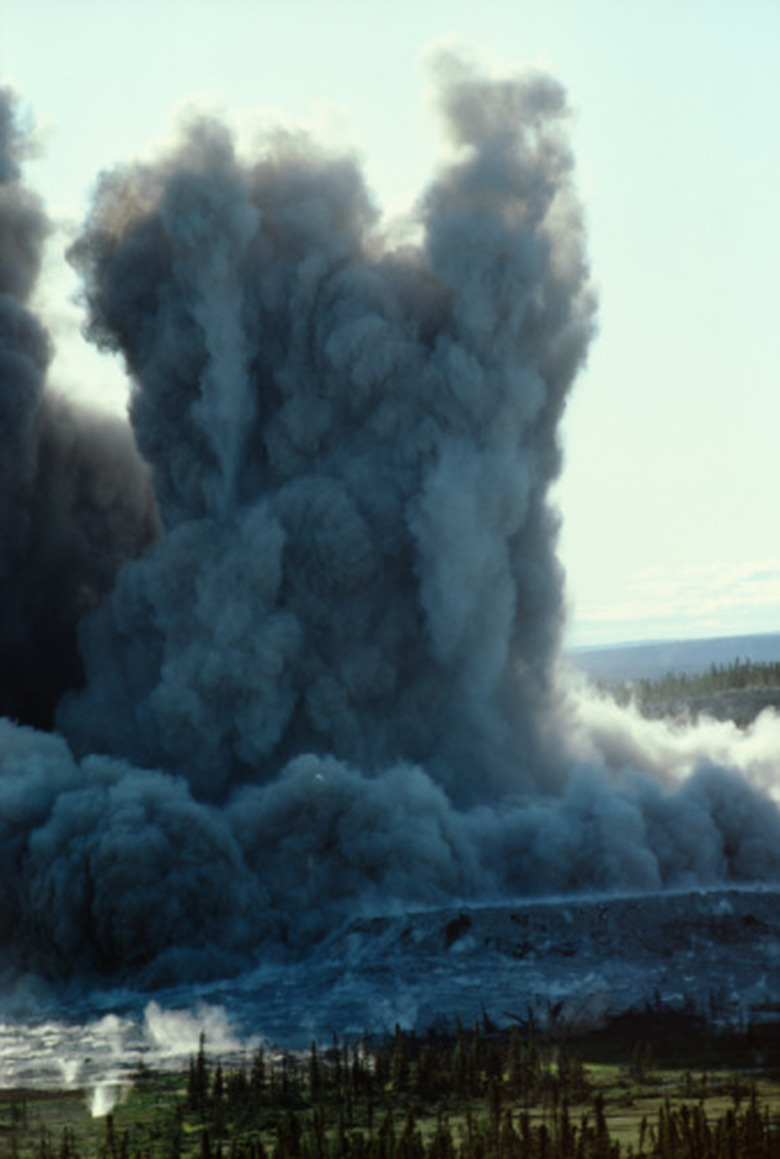How To Tell If A Reaction Will Occur
Some reactions are what chemists call thermodynamically spontaneous, which means that they occur without having to put work in to make them happen. You can determine whether a reaction is spontaneous by calculating the standard Gibbs free energy of reaction, the difference in Gibbs free energy between pure products and pure reactants in their standard states. (Remember that the Gibbs free energy is the maximum amount of non-expansion work you can get out of a system.) If the free energy of reaction is negative, the reaction is thermodynamically spontaneous as written. If the free energy of reaction is positive, the reaction is not spontaneous.
Step 1
Write out an equation representing the reaction you want to study. If you don't remember how to write reaction equations, click on the first link under the Resources section for a quick review. Example: suppose you want to know whether the reaction between methane and oxygen is thermodynamically spontaneous. The reaction would be as follows:
CH4 + 2 O2 —-> CO2 + 2 H2O
Step 2
Click on the NIST Chemical WebBook link under the Resources section at the end of this article. The window that will appear has a search field where you can type the name of a compound or substance (e.g. water, methane, diamond, etc.) and find more information on it.
Step 3
Look up the standard enthalpy of formation, the ΔfH°, of each species in the reaction (both products and reactants). Add the ΔfH° of each individual product together to get total ΔfH° for products, then add the ΔfH° of each individual reactant together to get ΔfH° of reactants. Example: The reaction you wrote includes methane, water, oxygen and CO2. The ΔfH° of an element such as oxygen in its most stable form is always set at 0, so you can ignore oxygen for now. If you look up ΔfH° for all the other three species, however, you will find the following:
ΔfH° methane = -74.5 kilojoules per mole ΔfH° CO2 = -393.5 kJ / mole ΔfH° water = -285.8 kJ / mole (notice that this is for liquid water)
The sum of ΔfH° for the products is -393.51 + 2 x -285.8 = -965.11. Notice that you multiplied the ΔfH° of water by 2, because there is a 2 in front of the water in your chemical reaction equation.
The sum of ΔfH° for the reactants is just -74.5 since oxygen is 0.
Step 4
Subtract the total ΔfH° of reactants from the ΔfH° total of products. This is your standard enthalpy of reaction.
Example: -965.11 – -74.5 = -890. kJ/mol.
Step 5
Retrieve the standard molar entropy, or S°, for each of the species in your reaction. Just as with the standard enthalpy of formation, add up the entropies of the products to get total product entropy and add up the entropies of the reactants to get total reactant entropy.
Example: S° for water = 69.95 J / mol K S° for methane = 186.25 J / mol K S° for oxygen = 205.15 J / mol K S° for carbon dioxide = 213.79 J / mol K
Notice that you have to count oxygen this time. Now add them up: S° for reactants = 186.25 + 2 x 205.15 = 596.55 J / mol K S° for products = 2 x 69.95 + 213.79 = 353.69 J / mol K
Notice that you have to multiply S° for both oxygen and water by 2 when adding everything up, since each has the number 2 in front of it in the reaction equation.
Step 6
Subtract S° reactants from S° products.
Example: 353.69 – 596.55 = -242.86 J / mol K
Notice that the net S° of reaction is negative here. This is partly because we are assuming one of the products will be liquid water.
Step 7
Multiply the S° of reaction from the last step by 298.15 K (room temperature) and divide by 1000. You are dividing by 1000 because the S° of reaction is in J / mol K, whereas the standard enthalpy of reaction is in kJ / mol.
Example: The S° of reaction is -242.86. Multiplying this by 298.15, then dividing by 1000 yields -72.41 kJ / mol.
Step 8
Subtract the Step 7 result from the Step 4 result, the standard enthalpy of reaction. Your resulting figure will be the standard Gibbs free energy of reaction. If it is negative, the reaction is thermodynamically spontaneous as written at the temperature you used. If it is positive, the reaction is not thermodynamically spontaneous at the temperature you used.
Example: -890 kJ / mol – -72.41 kJ/mol = -817.6 kJ/mol, by which you know that the combustion of methane is a thermodynamically spontaneous process.
Things Needed
- Pencil
- Paper
- Calculator
References
- "Chemical Principles: The Quest for Insight"; Peter Atkins, et al.; 2008
- "Organic Chemistry, Structure and Function"; Peter Vollhardt, et al.; 2011
Cite This Article
MLA
Brennan, John. "How To Tell If A Reaction Will Occur" sciencing.com, https://www.sciencing.com/tell-reaction-occur-8463115/. 24 April 2017.
APA
Brennan, John. (2017, April 24). How To Tell If A Reaction Will Occur. sciencing.com. Retrieved from https://www.sciencing.com/tell-reaction-occur-8463115/
Chicago
Brennan, John. How To Tell If A Reaction Will Occur last modified August 30, 2022. https://www.sciencing.com/tell-reaction-occur-8463115/
